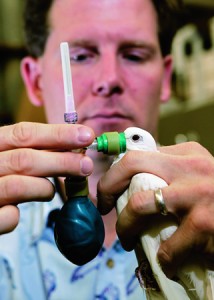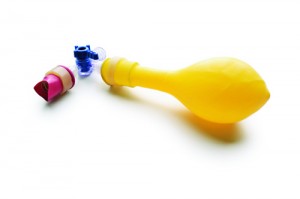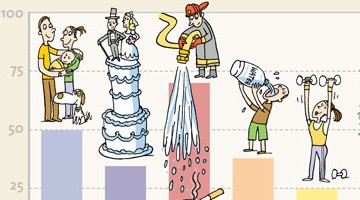A BYU researcher has sniffed out an unlikely source for data about bird behavior—bird breath.

As red leaves of sumacs and Virginia creepers begin to interrupt the monochromatic summer greens of Block Island, R.I., several hundred thousand migrating songbirds descend upon the site each fall to replenish energy and nutrient stores depleted during their southward journey. White-throated sparrows and yellow-rumped warblers attract another flock to the island—bird watchers, or bird catchers if you’re Kent A. Hatch (BS ’90). As an assistant professor of integrative biology, Hatch has traveled to Block Island once a year to catch birds and collect data. “Block Island has traditionally been farmed and grazed,” states Hatch. “This has kept the trees down and has allowed a lot of bushes to grow, which produce the fruits the birds eat. In this sense, it has become a very valuable stopover site for birds because of what humans have done.”
But recent human developments have unintentionally encroached upon the birds’ habitat. Farming and grazing are receding, and the island relies more on the tourist industry for its profit. With the diminished agricultural activity, the habitat is redeveloping and reforesting, and the bushes the birds ate from are disappearing.
To better understand bird behavior and human influence on it, Hatch, along with Scott R. McWilliams, of the University of Rhode Island, and David W. Podlesak, of the University of Utah, have tapped into a valuable, if unusual, source of information—bird breath. A few puffs of bird breath and some high-tech instrumentation enable scientists to uncover what a bird had for breakfast. With this information, ecologists can better protect a stopover site’s availability for hungry sparrows, warblers, and other birds.
Extinction and Prevention
Hatch’s interest in animals began when he was a child in West Bend, Wisc.—but his curiosity wasn’t exactly focused on preservation. He discovered that the hot summer sun will kill a crayfish in a bucket of water. “I tried to keep them as pets,” he recalls. “I wasn’t terribly successful at it.” But this didn’t stop his catch-and-keep cycle, which ended each time he peered into the bucket and discovered another lifeless crayfish. Disappointed, Hatch would then hurry off to the creek to catch another. Hatch jokes that his persistence led to crayfish extinction in that area.
In third grade Hatch’s interest in animals led him to read every book in his grade school library on whales, dolphins, and seals. Now, after receiving degrees in zoology, rather than contributing to animal extinction, Hatch has decidedly switched to the side of preservation and focuses his research on ways to help his fellow humans preserve animals and their ecologies.
Which is why he is interested in bird breath. Strange and unappealing as it may sound, bird breath, Hatch insists, unlocks a wide array of difficult-to-obtain data on bird feeding habits, which in turn provides people like the ecology-conscientious residents of Block Island with information about how their land-use decisions affect their semiannual feathery visitors.
But bird breath hasn’t traditionally been easy to come by, at least not until Hatch constructed the what he calls the “bird breathalyzer” during his postdoctoral fellowship in Israel. While there, Hatch had 18 months to gather bird-breath data. “I came up with all of these reasonable-sounding but complicated schemes,” Hatch recalls. A year passed without any success in obtaining a sample. “Something continually went wrong,” he says. “I had six months left, and I thought, ‘I’ve just got to get some data. Let’s find a quick, dirty, easy way to do it.’ I came up with a very simple method, which I should have done to begin with.” This method, the bird breathalyzer, uses a tiny three-way valve with a party balloon on one end, a bird-sized face mask on the second, and a syringe on the third.
Simple though it may be, the breathalyzer has proven effective in obtaining samples and has started Hatch on the road to redemption for childhood transgressions.
Catch and Collect
On Block Island, before the sun comes up and before the birds become active, Hatch and his partners set up fine-mist nets near fruit-bearing bushes. Mist nets, which are designed to trap small songbirds without injuring them, are barely noticeable from certain angles. As the sun rises and the birds become active, the nets prove their worth as birds fly into them and become entangled. Once a bird has been trapped in the netting, the team gently untangles it and places it in a cloth bag until it has calmed down. To obtain a breath sample, they place the face mask of the breathalyzer over the bird’s beak and wait 30 seconds while the bird inhales pure oxygen from the balloon and exhales carbon dioxide. When the balloon fills with carbon dioxide, they transfer the sample through the syringe to a sealed container for later study.

To determine what was on the menu for the bird’s most recent meals, Hatch and his colleagues later analyze the carbon-dioxide samples with a mass spectrometer in a lab. As birds eat at various stopping sites, the ratio of different forms, or isotopes, of carbon lingering on their breath will vary depending on their particular diet. When viewed with a mass spectrometer, isotopes provide a sort of fingerprint, or isotopic signature, for various foods.
At one site the team found that the birds had been eating from bird feeders on the island as well as from local vegetation. “If we hadn’t used this breath test, we wouldn’t have known that,” Hatch points out. “We always saw the birds at the site, but we didn’t know what they were eating when we weren’t watching them.”
Not Just for the Birds
Hatch’s breathalyzer has given scientists new clues concerning birds’ diets, and the technology is being applied elsewhere in the animal kingdom as well. Based on Hatch’s success with birds, BYU scientists are now also taking the breath away from other animals, including llamas, horses, and bears.
Professor of integrative biology Hal L. Black, who has been studying the American black bear for 14 years (see also “Bearing Assistance,” p. 19), recently added a much larger version of the breathalyzer to his methodological toolbox. “We began the breath analysis for the first time this winter,” says research assistant and former graduate student Joshua D. Heward (BS ’00). “It has been good to get some other information about these bears. The researchers are using the stable isotopes to get an idea of the types of foods the various bears are eating.”
Obtaining a breath sample from a bear isn’t exactly the same as from a bird, Hatch notes. For one, the bear needs to be sedated first. And the bear’s size makes it possible to simplify the breathalyzer even more. “The bear is a big animal and produces a lot of carbon dioxide,” Hatch says. No balloon is needed for this breathalyzer—just a large mask and a syringe to suck the air out.
“We want to look at the degree of carnivory,” Hatch says. “Is a mother that’s nursing young more carnivorous than one who isn’t?” As the breathalyzer begins to filter into other animal studies, it is being applied to more questions like this. “We’re at the very beginning of this,” says Hatch, who hopes the method will continue to provide useful information in a broad range of animal studies.
For now Hatch is exploring the breathalyzer’s potential for improving human impact on birds. In the case of Block Island, Hatch predicts that human changes to the environment will force birds to look elsewhere for food. “The trees are probably going to shade out the bushes, and they are going to die,” Hatch says. “The birds are going to have to find some other stopover site.” Island dwellers may have unwittingly set back a major part of the tourism industry they increasingly depend on.
“As we develop this land and as we change it, how does that affect a bird’s migration and their use of stopover sites?” Hatch asks. By identifying the birds’ preferred or accepted foods, ecologists can make recommendations on how to best maintain flock stopover sites that land development has encroached upon.
“Not everything that people do is bad for animals,” Hatch states. “Some things can be good for many species but not good for others. We need to learn how that all works.”









